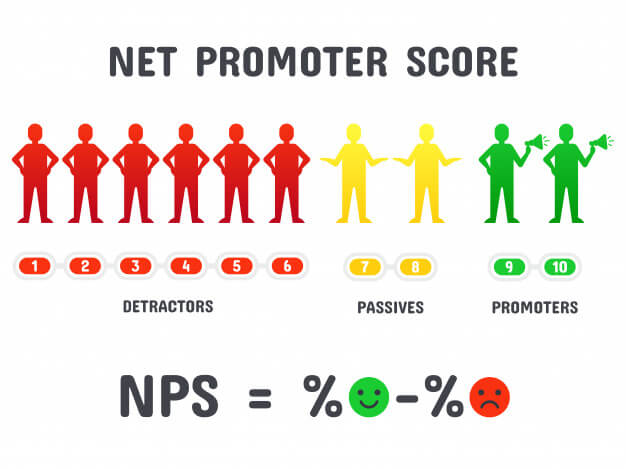
The term “Net Promoter Score” or “NPS’ is used to measure the satisfaction level of a company” s customers to recommend their brand to other customers, colleagues, friends, or family. It’s generally used as a customer experience metric to know what your customers think and feel about your products and services.
NPS is calculated with the help of numbers ranging from 0 to 10. It’s a straightforward indicator of customer experience. Organizations rely on NPS scores to understand customer satisfaction levels, use the scores to improve their offerings and work on improving their solutions.
Ways to measure Customer Satisfaction
Customer satisfaction is your customer’s overall satisfaction level, depending on the comfort level of your brand. There are multiple ways to evaluate customer satisfaction, depending on the influence on your overall customer experience indicator.
- Is your CX meeting your customer’s needs?
- Is your CX friendly and easy to use?
- Are your customers enjoying your CX?
How to calculate NPS

An NPS consists of (0-10) scores classified into detractors (0-6), passive (7-8), and promoters (9-10).
Promoters (9-10) – They are your brand ambassadors. They love your products and services, and instantly recommend you to other customers.
Passives (7-8) – They are satisfied but not happy. Even a small mistake can make them switch to your competitors. They don’t spread negative reviews but are also not enthusiastic about your offerings.
Detractors (0-6) – They are not satisfied with your brand at all. They won’t purchase anything from you again, which might damage your brand reputation through negative comments or word-of-mouth.
NPS = Promoters (%) – Detractors (%)
The Net Promoter Score (NPS) is calculated by subtracting the percentage of detractors from the promoters’ percentage. The score generated between -100 and 100 is the Net Promoter Score.
E.g., When surveyed, if all the customers gave a score equal to or lower to 6, it will give an NPS of -100. If all the customers gave a score between 9 to 10, the NPS score would be 100.
How to read NPS?
The basic fundamental of a Net Promoter Score is simple and easy to understand. It’s widely used in companies across the globe. If an organization has more detractors and fewer promoters, the score will be negative and vice-versa. Similarly, more promoters will give positive scores, but organizations will not know what changes to make in their products and services.
The Net Promoter Score will motivate frontline employees and help them improve and provide the best level of customer experience. NPS’s main objective is to convert your detractors into promoters and make them the brand ambassadors who can pass on positive word-of-mouth to other customers. It will improve business performance and increase revenue and profits.
How to increase NPS?
Firstly, calculating an NPS once in a while is not enough. It has to be a part of the organizational ecosystem, where employees understand NPS, follow it, and work on it continuously for improvement.
The Net Promoter Score mechanism has to be a company-wide effort with senior leadership’s involvement and assistance in improving CX. It cannot be handled alone by just one department – sales, marketing, operations, or customer service. Working in silos may not deliver the cross-functional approach needed for a perfect NPS.
Secondly, NPS has to work in a closed-loop environment. Frontline employees must be able to act upon real-time feedback from the customers and the rest of the organization. Be it sales, marketing, or customer experience team; everyone should be able to focus and learn from the acquired information.
Third, correctly analyze the data derived from the Net Promoter Score. NPS is simple to calculate, but unless your business dissects the number of detractors and identifies the root cause of the problem, it will miss out on sustainability, future growth, and profitability. Moreover, take into consideration factors that make detractors convert into promoters.
Steps for NPS Effectiveness
- Involve your team, and get your staff and senior management on board. Your team needs to understand the parameters involved by which you are going to plan, execute, and rectify customer’s issues.
- Create a customer journey map to find out the experience a customer has with your brand.
- Use a robust CX management system that knows NPS in and out. It empowers you to keep track of your customer interactions, gives a comprehensive view of your customer, both current and potential.
- Understand the factor that drives customer loyalty. Learn more about what influences customer behavior and feeling in providing positive feedback.
- Find the reason behind the score. Ask customers real open-ended questions like “What’s the reason for your score?”
- Ask them how you can better their customer experience. It will make customers feel that you can work on their feedback and make things interesting.
- Generate multiple data from customer’s journeys, multiple interactions, and various touchpoints.
- Encourage your customers to share feedback. Assign rewards and incentives, which will make them share feedback.
Get NPS in actions
Loyal customers stay with the brand for years. They know the brand in and out. Turn your loyal customers into brand advocates. Make them happy. Incentivize and make them feel great. Give them VIP treatment. Send a personal thank you note with small corporate merchandise. They will recommend you to their friends, families, and others around them.
Benefits and drawbacks of using NPS
The Net Promoter Score is a straightforward metric based on simple questions, logic, and criteria. It weighs the value of customer loyalty through referrals and syncs customer perceptions to visible business performance. NPS standardizes the process across industries and businesses – and creates a well-established benchmark. It has helped many companies streamline their customer experience and move towards a customer-centric culture.
However, like any other metrics, even NPS has limitations. The (0-10 point) scale, doesn’t have an option for negative feedback, making it difficult for companies to compare true detractors and non-promoters. The diversification of scores into detractors, promoters, and passives have turned data points into individual data.
Many organizations completely rely on NPS to measure customer satisfaction. They don’t realize that NPS only captures a few aspects of customer loyalty. It will be futile to depend on only one metric as it may not give you the complete picture of the customer experience.
Conclusion
The Net Promoter Score (NPS) is here to stay and is widely adopted by organizations worldwide. It’s a direct and conscious metric indicator that pulls each aspect of customer feedback. It works fine if you understand NPS shortcomings, and make adjustments to enhance it further. NPS alone cannot give you the whole scenario of customer feedback. NPS acts as a base, and it’s combined with user research; it will give you holistic insights. Use NPS to know what’s behind numbers and not the total face value.

